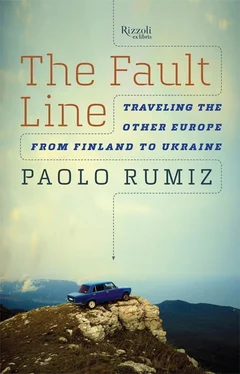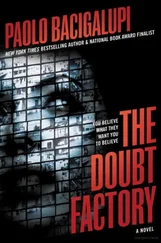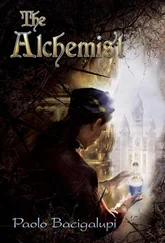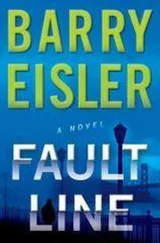The circumnavigation of Lake Ladoga, fully half as big as the Adriatic, turned out to be an act of pure railway masochism. Forty-five hours and six minutes from Petrozavodsk to Saint Petersburg, of which thirty hours and eight minutes were consumed by layovers at four different places, sometimes just a mile or two from the Finnish border. Stations in the middle of nowhere, under military control; villages out of this world, inhabited by Asians deported by Stalin to occupy the houses abandoned by the defeated Finns. People, I’ve been told, who feel secure only in militarized confinement.
Now, heading south from this “oversize” space, I’m passing into a world whose scale, horizons, and dimensions I know perfectly.
I’m leaving vertical Europe to reenter horizontal Europe. Now all the train lines begin to run perpendicular with respect to my chosen north-south heading. The frozen pole star of Murmansk vanishes from the train schedules. Now it’s a lot more common to see Berlin, Warsaw, Kiev, Leopolis (aka Lviv, Lvov, and Lemburg).
This train is running faster than the others. Even the noises it makes are changing. It no longer sounds a double beat of the wheels going over the joints in the track, but a single beat, loud, hammering in the rain. On the far shore of the Baltic Sea, the star-spangled flag of the European Union is already drawing us back toward Estonia.
But in Saint Petersburg the magic of the journey seems surprisingly renewed.
The names of the stations—Baltiyskaya, Pushkinskaya, Dostoyevskaya, Ladoskaya—conjure up mythological distances, and the throngs of humanity that fill them, condense in just a few hundred yards the immensity of the empire. Time zones upon time zones of ethnicities: Mongols, Caucasians, Central Asians and Siberians, peoples of the Baltic and short-headed natives of Khorasan, agitated head-turning beauties from Lake Baikal, Greeks from Crimea, women with that fabulous Circassian pallor, Turks with Astrakhan hats. On the subway, midshipmen from the naval academy, Orthodox nuns, micro miniskirts, drunken hooligans, old men absorbed in their books, happy campers. Handsome faces of a mature people that has known suffering more than any other.
On the Baltiyskaya line, a young invalid from the war in Chechnya with a bony, ferocious face, pushed from car to car in his wheelchair by a less than reputable-looking young man, literally extorts a “toll” from the passengers after yelling out a threatening appeal for solidarity. Police are everywhere, and the officers are of two kinds: black American-style uniforms or else muscle-bound giants in gray. Instructions not to leave bags unattended are posted everywhere you look, a precaution against terrorist attacks. Taking pictures is prohibited, but with her little noiseless Leica with no flash, Monika performs miracles.
At Baltiyskaya Station, half empty, we discover that Estonia is now farther away, the frontier more of a hassle, and visas harder to come by, especially in the last year, since the Estonians tore down the monument to the war dead of the Red Army and Putin vowed never to forget it. But it is above all since the collapse of the USSR followed by the independence of the Baltics, that train connections have virtually disappeared, and today what used to be the pieces of the union of fraternal peoples are reachable only by bus. At the ticket window, they detour us to the square in front of the station, where there’s a sign inscribed with the words BUS EUROLINES, YEVROPEISKY EKSPRESS, LINII. In just a few minutes, there is supposed to be a bus departing from there for Tallinn, capital of the land of the Estonians.
We run toward the bus with our backpacks. The engine is already running, and we ask the driver if it’s possible to get off at Narva, the first town over the border. An awesome place, we’ve been told, with a Swedish fortress and a Russian one built by Ivan the Terrible, facing each other from opposite river banks, and a road that pierces the frontier, running through the crenelated castle walls. The most scenic entrance anywhere into the star-spangled federation. One of those foreboding limites , with memories of the comings and goings of Russian, Swedish, and German armies. On the castle on the left bank, there is a plaque that commemorates the breach made by Peter the Great, who conquered the city in 1704.
“Narva?” the ticket seller asks in surprise. “Nobody gets off at Narva. I wouldn’t even know how much to make you pay.”
Inside the bus, drowsy women and some children. The windows are striped with rivulets of raindrops.
“Let’s say five hundred rubles.”
And here we go under the overcast sky, already Protestant, Berliner, Hanseatic, toward the hard languages of the Finno-Ugric world and the vocalic diaereses of Central Europe, along landscapes flattened by the wind and the blitzkriegs. We’re traveling across a terrain that’s perfect for generals and large-scale military maneuvers. In the rain, even the Orthodox churches lose their Byzantine force and take on the Gothic verticality of the fir trees.
At the last Russian town, we decide to get off and go the rest of the way on foot. If the two checkpoints are as close as they seem, crossing the border on foot is the best way to avoid lines. In fact, the bridge over the Narva has a lane for pedestrians, who, on the Estonian side, have an entrance just for them. We cross the river in the company of cyclists and old women with bags, young men in black blousons, globe-trotters, and some odd types with no baggage, lit cigarettes between their lips, and their hands in their pockets. Our return to “Europe” is superb, the Narva a deep green color frothing its way to the Baltic. On the left bank, on the towers of the Swedish fort, some seagulls are screaming.
“Passport, please.”
The Estonian police are condescending and vaguely irritating, like the Slovenian police. The newly admitted members of the EU are the most zealous in applying the rules of the club. But surprisingly, beyond the checkpoint, the city is still Russia. I try to pronounce two shameful monosyllables in Estonian, but the people passing by laugh and say “Don’t understand.” I discover that in all of eastern Estonia, Russian is still the lingua franca, because of the many ex-Soviets who have remained on the Baltic. I hear the same Slavic music on both sides of the river, and under the bridge, anglers from the western and eastern shores wade waist deep into the water and risk getting their lines tangled if their casts are too long.
The sharp sunlight is coastal, reminiscent of Lübeck and Travemünde. The architecture of the fortified bridge calls to mind the Bosnia of Višegrad in the novel by Ivo Andrić, The Bridge on the Drina . By now we’re in deep Central Europe. The ravens, big and black, are the same as the ones on the Polish plains and in the Balkans. The sight of the first stork, the first linden tree, the first oak, and the first horse chestnut tree makes our hearts skip a beat. While the signs of technological modernity of the West darken my mood, the encounter with the trees of the South warms my soul.
Something completely new appears on my horizon: a pretty little hotel with reasonable rates and a concierge who speaks English. In Russia, I had no choice: either forgotten provincial ruins or overpriced penitentiaries for the rich. The cleanliness is a step up, too.
The city looks like a drab pharmacy, and everything seems a little fake—a city of doorbells, a Legoland populated by timid gnomes with a tendency to solitary drunkenness. Under the hegemony of the Estonians, close relatives of the taciturn Finns, the Russian minority has two survival strategies: assimilate and don’t call too much attention to yourself, like Antonia Timofeyevna, who is chatting with a friend on a bench; or ostentatiously display your identity, like the two seedy-looking gorillas who are parking their flaming red Mazda with the 900-RUS license plate in front of a restaurant where they act as though they own the place.
Читать дальше












